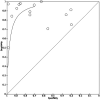The role of artificial intelligence in the endoscopic diagnosis of esophageal cancer: a systematic review and meta-analysis
- PMID: 37480192
- PMCID: PMC10789250
- DOI: 10.1093/dote/doad048
The role of artificial intelligence in the endoscopic diagnosis of esophageal cancer: a systematic review and meta-analysis
Abstract
Early detection of esophageal cancer is limited by accurate endoscopic diagnosis of subtle macroscopic lesions. Endoscopic interpretation is subject to expertise, diagnostic skill, and thus human error. Artificial intelligence (AI) in endoscopy is increasingly bridging this gap. This systematic review and meta-analysis consolidate the evidence on the use of AI in the endoscopic diagnosis of esophageal cancer. The systematic review was carried out using Pubmed, MEDLINE and Ovid EMBASE databases and articles on the role of AI in the endoscopic diagnosis of esophageal cancer management were included. A meta-analysis was also performed. Fourteen studies (1590 patients) assessed the use of AI in endoscopic diagnosis of esophageal squamous cell carcinoma-the pooled sensitivity and specificity were 91.2% (84.3-95.2%) and 80% (64.3-89.9%). Nine studies (478 patients) assessed AI capabilities of diagnosing esophageal adenocarcinoma with the pooled sensitivity and specificity of 93.1% (86.8-96.4) and 86.9% (81.7-90.7). The remaining studies formed the qualitative summary. AI technology, as an adjunct to endoscopy, can assist in accurate, early detection of esophageal malignancy. It has shown superior results to endoscopists alone in identifying early cancer and assessing depth of tumor invasion, with the added benefit of not requiring a specialized skill set. Despite promising results, the application in real-time endoscopy is limited, and further multicenter trials are required to accurately assess its use in routine practice.
Keywords: cancer screening; endoscopic imaging; esophageal cancers; robotics.
© The Author(s) 2023. Published by Oxford University Press on behalf of International Society for Diseases of the Esophagus. All rights reserved. For permissions, please e-mail: journals.permissions@oup.com.
Figures





References
-
- Siegel R L, Miller K D, Fuchs H E, Jemal A. Cancer statistics, 2022. CA Cancer J Clin 2022; 72(1): 7–33. - PubMed
-
- World Health Organisation . Cancer Today [Internet]. International Agency for Research on Cancer [Cited 12 Feb 2023]. Available from: https://gco.iarc.fr/today/online-analysis-table?v=2020&mode=cancer&mode_...
-
- Tokai Y, Yoshio T, Aoyama K et al. Application of artificial intelligence using convolutional neural networks in determining the invasion depth of esophageal squamous cell carcinoma. Esophagus 2020; 17(3): 250–6. - PubMed
-
- Veitch A M, Uedo N, Yao K, East J E. Optimizing early upper gastrointestinal cancer detection at endoscopy. Nat Rev Gastroenterol Hepatol 2015; 12(11): 660–7. - PubMed
Publication types
MeSH terms
LinkOut - more resources
Full Text Sources
Medical
Miscellaneous

